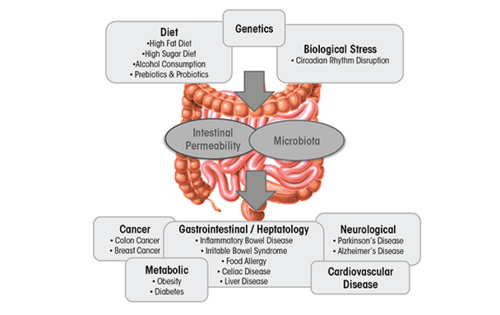Alcoholism and its Effects on Gut Microbiome: Difference between revisions
No edit summary |
No edit summary |
||
| Line 3: | Line 3: | ||
[[Image:Figure_1_gut_microbiome_and_alcohol.png|thumb|500px|right|This illustration depicts a three-dimensional (3D), computer-generated image, of a group of Gram-positive, Streptococcus agalactiae (group B Streptococcus) bacteria. The photo credit for this image belongs to Alissa Eckert, who is a medical illustrator at the [http://www.cdc.gov/ CDC].]] | [[Image:Figure_1_gut_microbiome_and_alcohol.png|thumb|500px|right|This illustration depicts a three-dimensional (3D), computer-generated image, of a group of Gram-positive, Streptococcus agalactiae (group B Streptococcus) bacteria. The photo credit for this image belongs to Alissa Eckert, who is a medical illustrator at the [http://www.cdc.gov/ CDC].]] | ||
<br>By Nikola Kovacova <br> | <br>By Nikola Kovacova <br> | ||
<br>The gut microbiota is classified as a collection of all microbial organisms within the gastrointestinal tract (GIT).<ref name=Savage> [https://doi.org/10.1146/annurev.mi.31.100177.0005430 Savage, D.C. "Microbial ecology of the gastrointestinal tract." Annual review of microbiology, 31, 107–133.]</ref> With trillions of microorganisms inhabiting the microbiota, its collective genome is believed to encode 100 times more genes than the human genome.<ref name=Qin>[https://doi.org/10.1038/nature08821 Qin, J., Li, R., Raes, J., Arumugam, M., Burgdorf, K. S., Manichanh, C., Nielsen, T., Pons, N., Levenez, F., Yamada, T., Mende, D. R., Li, J., Xu, J., Li, S., Li, D., Cao, J., Wang, B., Liang, H., Zheng, H., Xie, Y., … Wang, J. (2010). "A human gut microbial gene catalogue established by metagenomic sequencing." Nature, 464(7285), 59–65.]</ref>This makes it not only a complex, but also an essential player involved in the health status of the GIT, as it impacts digestion, inflammation and immunity.<ref name=Leclercq>[https://doi.org/10.1038/tp.2017.15 Leclercq, S., de Timary, P., Delzenne, N. M., & Stärkel, P. (2017). "The link between inflammation, bugs, the intestine and the brain in alcohol dependence." Translational psychiatry, 7(2), e1048.]</ref> | <br>The gut microbiota is classified as a collection of all microbial organisms within the gastrointestinal tract (GIT).<ref name=Savage> [https://doi.org/10.1146/annurev.mi.31.100177.0005430 Savage, D.C. "Microbial ecology of the gastrointestinal tract." Annual review of microbiology, 31, 107–133.]</ref> With trillions of microorganisms inhabiting the microbiota, its collective genome is believed to encode 100 times more genes than the human genome.<ref name=Qin>[https://doi.org/10.1038/nature08821 Qin, J., Li, R., Raes, J., Arumugam, M., Burgdorf, K. S., Manichanh, C., Nielsen, T., Pons, N., Levenez, F., Yamada, T., Mende, D. R., Li, J., Xu, J., Li, S., Li, D., Cao, J., Wang, B., Liang, H., Zheng, H., Xie, Y., … Wang, J. (2010). "A human gut microbial gene catalogue established by metagenomic sequencing." Nature, 464(7285), 59–65.]</ref>This makes it not only a complex, but also an essential player involved in the health status of the GIT, as it impacts digestion, inflammation, and immunity.<ref name=Leclercq>[https://doi.org/10.1038/tp.2017.15 Leclercq, S., de Timary, P., Delzenne, N. M., & Stärkel, P. (2017). "The link between inflammation, bugs, the intestine and the brain in alcohol dependence." Translational psychiatry, 7(2), e1048.]</ref> | ||
==How to Analyze the Intestinal Microbial Population?== | ==How to Analyze the Intestinal Microbial Population?== | ||
Revision as of 18:12, 11 April 2023
Introduction

By Nikola Kovacova
The gut microbiota is classified as a collection of all microbial organisms within the gastrointestinal tract (GIT).[1] With trillions of microorganisms inhabiting the microbiota, its collective genome is believed to encode 100 times more genes than the human genome.[2]This makes it not only a complex, but also an essential player involved in the health status of the GIT, as it impacts digestion, inflammation, and immunity.[3]
How to Analyze the Intestinal Microbial Population?
Include some current research, with at least one figure showing data.
Every point of information REQUIRES CITATION using the citation tool shown above.
==Alcohol as a Culprit of Dysbiosis in the Intestinal Microbiota
==
Include some current research, with at least one figure showing data.
Alcohol as a Culprit of Dysbiosis in the Intestinal Microbiota
Include some current research, with at least one figure showing data.
Alcohol-Induced Diseases of the GIT
Possible Treatments and Therapeutic Interventions
Conclusion
References
- ↑ Savage, D.C. "Microbial ecology of the gastrointestinal tract." Annual review of microbiology, 31, 107–133.
- ↑ Qin, J., Li, R., Raes, J., Arumugam, M., Burgdorf, K. S., Manichanh, C., Nielsen, T., Pons, N., Levenez, F., Yamada, T., Mende, D. R., Li, J., Xu, J., Li, S., Li, D., Cao, J., Wang, B., Liang, H., Zheng, H., Xie, Y., … Wang, J. (2010). "A human gut microbial gene catalogue established by metagenomic sequencing." Nature, 464(7285), 59–65.
- ↑ Leclercq, S., de Timary, P., Delzenne, N. M., & Stärkel, P. (2017). "The link between inflammation, bugs, the intestine and the brain in alcohol dependence." Translational psychiatry, 7(2), e1048.
Authored for BIOL 238 Microbiology, taught by Joan Slonczewski, 2023, Kenyon College
